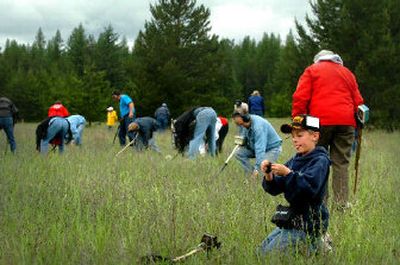Looking for lost treasure

Join a book club, you’ll get a new novel. Join a cooking club, you’ll get lunch. Join the Northwest Treasure Hunters Club and you might get a 34-ounce gold nugget.
The club is an 80-member group of metal detector enthusiasts that meets once a month in Spokane. Members search alone and together in parks, schools, yards, historical sites and fairgrounds, finding coins, jewelry, toys, bullets, knives and knickknacks. Sometimes their finds were dropped the day before; sometimes they are 130 years old.
The club meetings feature raffles and drawings, and members show off their newest treasures. Everyone, including guests, votes on which finds are most impressive. June winners included a 14-carat aquamarine ring with six diamonds and a soldier’s hatpin from the 1850s, found at Fort Shaw, Mont. There also were an old flask full of spirits, an iPod, old bullets and plenty of valuable change.
The most valuable club find was a 34-ounce gold nugget, worth as much as $30,000, uncovered in 2004 by Steve Burring on a trip to Alaska.
People hunt for a variety of reasons. Burring says the thrill of finding a silver coin never goes away, even after he found the $30,000 nugget. Lucile Bowen, 81, hunts because, “It’s like a gamble. Every time you go out, you don’t know what you’re going to find.”
Larry “Packrat” Bateham, perhaps the club’s most active member, is 53, and started hunting when he was 18. He tries to hunt at least once a week. His favorite part, which he calls his “life’s philosophy,” is the people.
“The most important thing is to make a new friend each meeting,” he said. “Everything else is just gravy.”
Bateham, with his beard, cowboy hat and long hair, is never without a smile. He has met people from California, Canada and Florida through treasure hunting.
“I would trust anybody in this club with anything I have; they’re just that kind of people,” he said.
The club’s president, Clay Soliday, agrees. “It’s more fun (to hunt) as a group or at least with a partner,” he said. “One of the worst things that can happen is when you get a good find and there’s no one to show it to.”
There’s more to the group than private hunts and monthly meetings. There are picnics and barbecues, a Christmas potluck with Santa, a snow bear hunt and a scavenger hunt. The year’s highlight was the annual hunt, held each June at Idaho’s Farragut State Park. The event features coin hunts, kid hunts, a gold-panning contest. More than 40,000 coins are buried. Some 135 hunters turned out for the 34th annual hunt. The 25th hunt had 250 hunters. Soliday believes rising gas prices are harming attendance.
The club also sponsors an ongoing “Penny Plaque” hunt. A plate made of commemorative coins is hidden each month in a public spot, and members are given clues to its location. This month, Alex Biviano found the plaque under a park slide. Alex doesn’t own a metal detector. In fact, he’d never heard of the club before finding the plaque – he’s only 7 years old.
“I thought it was real gold!” said Alex. “I just grabbed and thought it was just a whole bunch of coins, but it was the penny plaque!”
His father, Andrew, told the club, “Let me tell you, it made his day; you made one kid very, very happy.”
Alex’s reward is eight special coins, including an old silver dollar. “This used to be $1, since it’s silver,” he explained, “but now it”s $8, because it’s really old.” He plans to share the coins with his 5 1/2-year-old brother Aidan.
You might think that amid the coins and bullets, treasure hunters also find metal shavings and cans, but for this group, there’s no such thing as junk. Members turn in aluminum can pull tabs for cash to donate to the Ronald McDonald House, hold an annual canned food drive and return lost items to their original owners.
In 1999, Soliday found and returned a 1952 graduation ring from the United States Naval Academy. Bateham once helped a pastor’s wife find her wedding ring, and as a reward, got to search their churchyard. He found 250 coins, 200 of which were “old keepers,” including a 1931 S wheat penny worth $50.
A metal detector can easily cost $300, and annual club dues are $30 – but this activity often pays for itself. If you join, remember Bateham’s words when you find your first 1890 quarter: “The real treasures are the people you meet along the way.”